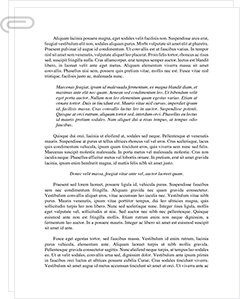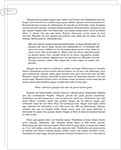 Study Document
Study Document
Understanding the Controversy of Corporal Punishment Essay
Pages:6 (1796 words)
Sources:10
Document Type:Essay
Document:#967229
Introduction
Corporal punishment has been a controversial topic throughout history, with strong arguments presented by both supporters and opponents of the practice. Corporal punishment is defined as the use of physical force intended to cause pain or discomfort in response to a perceived wrongdoing. This form of discipline has been used for centuries in various contexts, including schools, homes, and institutions.
Advocates of corporal punishment argue that it is an effective deterrent for inappropriate behavior, instills discipline, and teaches individuals the consequences of their actions. They believe that physical punishment is necessary to ensure obedience and respect for authority. Some also argue that corporal punishment can be quick and efficient, saving time and resources in the long run.
On the other hand, opponents of corporal punishment suggest that it is ineffective in promoting positive behavioral change and can lead to negative outcomes, such as increased aggression, resentment, and emotional trauma. They argue that there are more humane and effective ways to discipline individuals, such as positive reinforcement and dialogue. Additionally, corporal punishment has been criticized for perpetuating a cycle of violence and harm, rather than fostering a healthy environment for growth and development.
In recent years, there has been a growing movement against the use of corporal punishment, with many countries and organizations advocating for its abolition. As society continues to evolve and values shift towards non-violent forms of discipline, the debate surrounding corporal punishment remains an important and relevant issue in the field of education and child-rearing.
Understanding Corporal Punishment
Corporal punishment can be defined as the use of physical force with the intention of causing a child to experience pain, but not injury, for purposes of correction or control of the childs behavior. Although the practice has been a common method of discipline for centuries, it has become a controversial topic in modern times with many organizations advocating for its abolition.
Historical Perspectives
To fully understand the debate surrounding corporal punishment, it's essential to look at its historical context. Historically, corporal punishment was considered a standard aspect of education and child-rearing. The adage spare the rod and spoil the child reflects a period when physical punishment was regarded as key to maintaining discipline. In some ancient civilizations, such as those of Greece and Rome, physical discipline was a common aspect of pedagogy, serving as a method to teach self-control and respect for authority.
However, as societies evolved, perspectives on corporal punishment began to shift. Movements in Europe, particularly influenced by the Enlightenment thinkers, began to question the morality and effectiveness of corporal punishment. Key figures such as John Locke and Jean-Jacques Rousseau argued against harsh methods of discipline on the grounds that they were inhumane and counterproductive to a child's moral and intellectual development.
Public Opinion and Social Norms
Public opinion on corporal punishment has seen a significant transformation in recent decades. In the early and mid-20th century, physical punishment was widely accepted in most societies. However, public opinion began to shift away from this stance as research into child development and psychology became more widespread.
Gershoff and Grogan-Kaylors meta-analysis, Spanking and Child Outcomes: Old Controversies and New Meta-Analyses, reflects a growing body of literature that emphasizes the negative outcomes associated with corporal punishment. Their work, along with others, has been influential in swaying public opinion towards viewing spanking and other forms of physical punishment as detrimental to a child's well-being.
Legal Status and Global Trends
Legislative reforms have echoed the changing sentiments towards corporal punishment. In the last few decades, many countries have passed laws to restrict or completely ban physical punishment in homes and schools. Sweden was a pioneer in this regard, banning all corporal punishment of children in 1979, stimulating a global trend. Now over 60 countries have prohibited physical punishment in all settings, including at home. Conversely, in other parts of the world, such as in numerous states of the USA, some forms of corporal punishment in the home are still considered legal as clarified in Straus and Paschalls work, Corporal Punishment by Mothers and Development of Children's Cognitive Ability: A Longitudinal Study of Two Nationally Representative Age Cohorts.
The United Nations Convention on the Rights of the Child, which has been ratified by almost all member countries except the United States, urges states to protect children from "all forms of physical or mental violence," implicitly condemning corporal punishment. As outlined in Freemans Children's health and children's rights, the convention is shaping domestic policy in many countries by asserting children's rights to physical integrity and dignity.
Psychological and Behavioral Impacts
The impact of corporal punishment on children's psychological and behavioral development has been a focal point of research. Afifi et al. in their study, Physical Punishment and Mental Disorders: Results from a Nationally Representative US Sample, suggest that the use of corporal punishment is associated with an increase in mental health disorders in children. These findings are also supported by Grogan-Kaylors work, which found that corporal punishment increases the likelihood of a range of adverse outcomes, including aggression, antisocial behavior, mental health problems, and negative relationships with parents.
Moreover, the American Academy of Pediatrics strongly advises against the use of corporal punishment as a form of child discipline as outlined by Sege and Siegel in their policy statement titled "Effective Discipline to Raise Healthy Children," highlighting the potential for negative developmental outcomes and the lack of evidence for any long-term benefits of…
…Conclusion
Corporal punishment remains a contentious and complex issue, embedded with historical roots, cultural expectations, and legal implications. While the tide is shifting towards a global consensus on the need to protect children from all forms of violence, including physical punishment, the deeply ingrained nature of corporal punishment in some regions and cultures makes the transition towards non-violent forms of child rearing challenging.
As society continues to grapple with this issue, the role of research and evidence-based practice is crucial. Current literature overwhelmingly supports the view that corporal punishment has the potential to harm children's psychological, behavioral, and cognitive development. As more countries join the move to legislate against corporal punishment and promote positive discipline, it is likely that future generations will view this form of punishment as an archaic and unnecessary aspect of childhood.
The ongoing discourse on corporal punishment presents an opportunity for education, legislative reform, and societal change. It highlights the need to re-evaluate traditional disciplinary methods and prioritize the well-being and rights of children. In doing so, we create the foundation for a society that respects the dignity of every individual from the earliest stages of life.
References
Afifi, Tracie O., et al. Physical Punishment and Mental Disorders: Results from a Nationally Representative US Sample. Pediatrics, vol. 130, no. 2, 2012, pp. 184-192.
Durrant, Joan E. Positive Discipline in Everyday Parenting. Save the Children Sweden, 2011.
Freeman, Michael. Children's health and children's rights. Pediatrics, vol. 121, no. 4, 2008, pp. 803-809.
Gershoff, Elizabeth T., and Andrew Grogan-Kaylor. Spanking and Child Outcomes: Old Controversies and New Meta-Analyses. Journal of Family Psychology, vol. 30, no. 4, 2016, pp. 453-469.
Grogan-Kaylor, Andre. The Effect of Corporal Punishment on Anti-Social Behavior in Children. Social Work Research, vol. 25, no. 3, 2001, pp. 153-162.
Sanders, Matthew R. Development, Evaluation, and Multinational Dissemination of the Triple P-Positive Parenting Program. Annual Review of Clinical Psychology, vol. 8, 2012, pp. 345-379.
Sege, Robert D., and Benjamin S. Siegel. Effective Discipline to Raise Healthy Children. Pediatrics, vol. 142, no. 6, 2018.
Straus, Murray A., and Mallie J. Paschall. Corporal Punishment by Mothers and Development of Children's Cognitive Ability: A Longitudinal Study of Two Nationally Representative Age Cohorts. Journal of Aggression, Maltreatment & Trauma, vol. 18, no. 5, 2009, pp. 459-483.
The United Nations Convention on the Rights of the Child. United Nations, 1989.
United Nations Committee on the Rights of the Child. General Comment…
Related Documents
 Study Document
Study Document
Corporal Punishment and Child Rearing
However, there may be cases when a mild form of corporal punishment such as spanking on buttocks in a reasoned and caring manner, under certain conditions, may have beneficial effects. It is also my opinion -- and for this I am heavily indebted to Cleverley and Phillips -- that no rival model should be rejected outright. All our paradigmatic assumptions must be critically analyzed before we come to a
 Study Document
Study Document
Retribution for Criminal Punishment Every
1446) and it also reinforces that the offender's actions are not taken seriously by the government. A retributive system for criminal punishment accomplishes the ideal of equal liberty under law (Markel, 2004). When an individual commits a crime, they not only assert superiority over their victim, but also claim superiority, however implied, over the government body and practice of legal liberty. Acts of wrongdoing are paired with consequences -- it
 Study Document
Study Document
Pros and Cons of Positive and Negative Reinforcement in Toddlers
Positive and Neg. Rein Toddler Social learning theory has given parenting and child development a new lease on life. With the current focus in psychology, and more specifically child psychology, many researchers, educators, child-care providers and parents have gained a new understanding of the intricacies of positive and negative reinforcement and the impact both have upon children. Social learning theory asserts that learning or knowledge acquisition and behavior do not
 Study Document
Study Document
History of the American South
However, they "were too few in number to provide adequate protection and were not always themselves fully committed to ensuring justice for freed blacks" (Cary Royce 67). The American public wanted reform to happen but few people were actually willing to risk their position in society by supporting black people. As a consequence, former slaves were provided with little support and were practically forced to maintain many of their
 Study Document
Study Document
Political Protest the Current "Occupy: Insert Location
Political Protest The current "Occupy: (insert location name here)" movement is something that has been on the minds of many over the last few weeks and months, not because the awareness of the issues are new but mostly because the movement is demonstrative of a sweeping political protest like the U.S. has not seen in many years. The political science of protest is one that demonstrates the allowance of change in
 Study Document
Study Document
Behavioral and Long-Term Effects of Spanking Behavioral
Behavioral and Long-Term Effects of Spanking Behavioral and Long-Term Effect of Spanking Many of the studies pointed out that violence of adult are traced in the pattern of violence at home, and mostly in the experience of spanking during childhood. Despite the information and advocacy available in almost all media these days, there are still parents who thought that spanking their children to emphasize discipline is still beneficial. The benefits cited by




